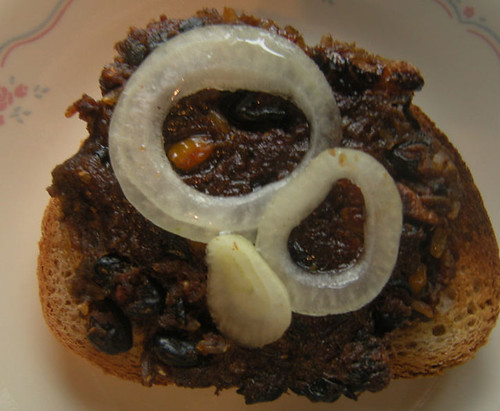
Black beans, an uncertain amount, but it looks like it was at least 3-4 cups once they were cooked up.
2-2.5 cups cooked brown rice
1 11 oz can of "Mexican corn," drained.
2 small onions
4-5 large cloves of garlic
1 package of taco seasoning
Teaspoon-ish of salt
2-ish teaspoons of freshly ground pepper
1/3 cup olive oil + oil for cooking
1-ish cup of vital wheat gluten
Sautee onions and garlic in oil, and mix up with previously cooked and cooled black beans, corn, rice, taco seasoning, salt, pepper, olive oil, VWG. Form into patties, place into oiled pans, and bake to your favorite stage of done. We like them crispy, so they get cooked at 400F for 45-90 minutes, depending on how much liquid is in each patty.
I did not add any liquid seasoning to this, and left the additional liquid requirement (beyond the oil) off this time because I had cooked the black beans from dried a couple of days ago. There was plenty of bean gravy attached to the beans, so no need to add more liquid. The beans were cooked with 2 sliced carrots, chopped onions, a clove of garlic, salt, and a splash of oil.
Michael felt like this was the best batch I'd made yet, and they were quite nice even straight from the oven; the VWG flavor I usually get while these things are still hot wasn't present.
Again, the only thing I really don't like about the process is the amount of time that it takes to make them and bake them. The mixing is pretty fast, so if I was using canned beans it would go faster, but I still need to precook the rice, and it takes a significant amount of time to cook them to the stage of done we like. Whatever savings one might be getting in terms of food cost is more than offset by the fuel cost and time cost. I'll keep making them, though, because I like controlling the ingredients and having more variety than the few commercial brands available that are soy and egg free.
ETA, 2 Nov 10, 12:40 AM: The veggie burger engine has reappeared.


 It worked out okay! It'll be easy to mod for a version I can eat, I think. I didn't have tomatoes, so I subbed 12 oz of tomato paste and 36 oz of water, and ground beef for lamb. Since I was making this for Michael, I made the
It worked out okay! It'll be easy to mod for a version I can eat, I think. I didn't have tomatoes, so I subbed 12 oz of tomato paste and 36 oz of water, and ground beef for lamb. Since I was making this for Michael, I made the